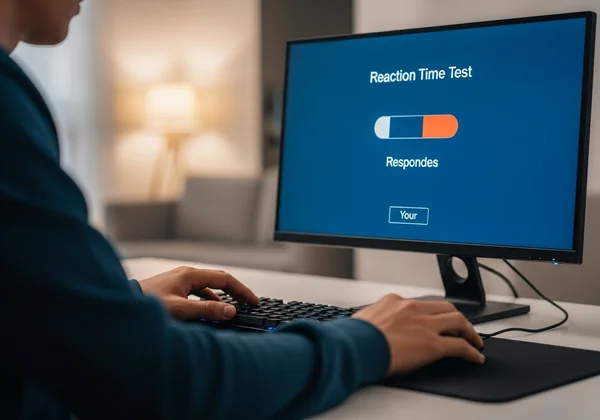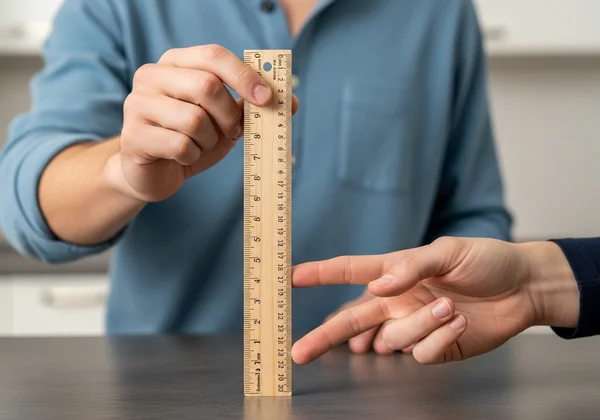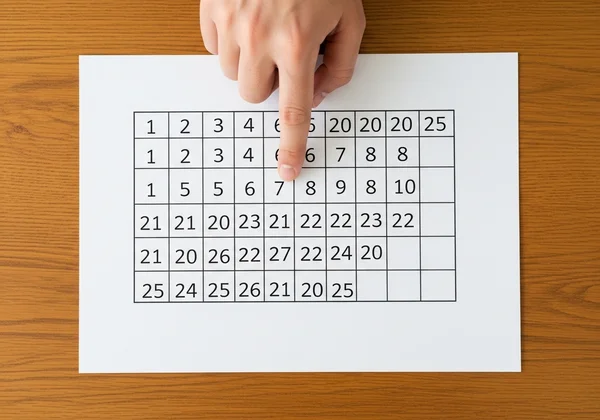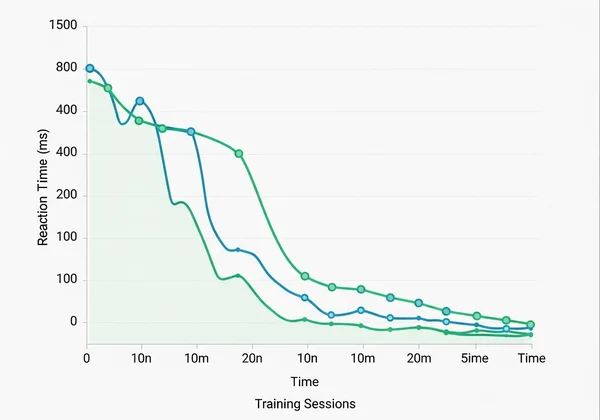10 Reaction Time Drills: Improve Your Reflexes with Our Reaction Time Test at Home
Feeling a step behind in games, sports, or even daily tasks? Your reaction time is a critical skill that directly impacts performance and safety. While many seek to improve, finding actionable, accessible methods without special equipment can be challenging. This guide, combined with a benchmark from a reaction time test, provides 10 powerful reaction time drills you can do at home to sharpen your reflexes and gain a competitive edge. How to improve reaction time for gaming? It starts with consistent practice, and the first step is knowing your baseline. Before you begin, take our free reaction time test to see where you stand.

Mastering Your Reflexes: Understanding Reaction Speed and Why Drills Work
Before diving into the exercises, it's crucial to understand what you're training. Reaction time isn't just about moving fast; it's a complex cognitive process. These drills are designed to strengthen the neural pathways responsible for that process, making your responses quicker and more accurate over time. Consistent training helps your brain become more efficient at processing information and sending signals to your muscles.
What is a Good Reaction Time, and Why Should You Test It?
Reaction time is the interval between when you perceive a stimulus and when you initiate a response. For a gamer, it’s seeing an opponent and clicking the mouse. For an athlete, it's the crack of the starting pistol and exploding off the blocks. Mastering this skill could be your edge, the difference between winning and losing a match, avoiding an accident on the road, or simply feeling more alert and coordinated in your daily life. A faster reaction time is a direct indicator of a more efficient nervous system.
The Science Behind Improving Reflexes and Neural Pathways
Each repetition of a reaction drill reinforces specific neural pathways. This concept, known as neuroplasticity, is your brain's ability to reorganize itself by forming new neural connections. Consistent and focused training makes these pathways more robust, allowing electrical signals to travel faster from your brain to your body. Think of it as upgrading a narrow country lane into a multi-lane highway—information travels much more efficiently, resulting in a measurable improvement in your reflexes. The improvements can be directly measured by taking a reaction time test before and after your training regimen.

Foundational Reflex Training: Improve Reflexes At Home
You don't need a high-tech gym to start improving. These foundational drills use common household items to build a solid base for quicker reflexes. After a week of practicing these, try our reaction time test again using our reaction speed test tool to see your progress.
Drill 1: The Classic Ruler Drop Test (Visual Processing)
This is a simple yet effective way to measure and improve your response to visual stimuli. Have a partner hold a ruler vertically, with the "0" mark hanging just above your open thumb and index finger. Without warning, they will drop it. Your goal is to catch it as quickly as possible. Note the measurement where you caught it—the lower the number, the faster your reaction. This drill hones your visual processing and motor response.
Drill 2: Hand-Eye Coordination Wall Toss (Precision & Speed)
Stand about arm's length from a wall with a small ball, like a tennis ball. Toss the ball against the wall with one hand and catch it with the other. Increase the speed and vary the target on the wall to challenge your precision & speed. This exercise forces your brain to quickly calculate the ball's trajectory and coordinate your hand to be in the right place at the right time, a key skill for any competitive activity.
Drill 3: Card Catch Challenge (Anticipation & Grip Reflexes)
For this drill, have a partner hold a playing card by its top edge. Place your hand, palm up, a few inches below it. Your partner will drop the card without warning, and your task is to flip your hand over and snatch the card before it hits the ground. This drill is excellent for developing anticipation & grip reflexes, forcing a rapid response to a silent, unpredictable visual cue.

Dynamic Quick Reaction Exercises for Enhanced Agility
Once you've mastered the basics, it's time to add movement and complexity. These dynamic drills are designed to improve your agility and decision-making speed, which are critical for athletes and gamers who need to react while in motion.
Drill 4: Partner Ball Toss & Catch (Peripheral Vision Training)
Stand facing a partner a few feet away. Have them toss a small ball towards you, but instruct them to aim slightly to your left or right, not directly at you. Your goal is to react and catch the ball using your peripheral vision. This is a fantastic exercise for peripheral vision training, forcing you to respond to stimuli outside your direct line of sight—just like spotting an enemy on the edge of your screen in a game.
Drill 5: Directional Tap Drills (Choice Reaction Speed)
This drill enhances your choice reaction speed, which is your ability to respond correctly to one of several possible signals. You can do this by placing different colored sticky notes on a wall. Have a partner call out a color, and your job is to tap the correct note as quickly as possible. This forces you not only to react but also to make a split-second decision, a vital skill in complex situations. You can measure your progress with a simple click test after your sessions.
Drill 6: Mirroring Exercises (Visual Tracking & Mimicry)
Face a partner and have them make random, unpredictable movements with their hands or body. Your objective is to mirror their movements as quickly and accurately as you can. This drill sharpens your visual tracking & mimicry, training your brain to observe and replicate actions in real-time. It’s a fun way to improve your reactive agility without any equipment.
Advanced Reflex Training Without Equipment Daily
The most advanced training focuses on the cognitive side of reaction time. These drills can be done almost anywhere and are designed to make your brain's processing speed lightning-fast.
Drill 7: Number Grid Tapping (Cognitive Speed & Accuracy)
Draw a 5x5 grid on a piece of paper and randomly write the numbers 1 through 25 in the boxes. The goal is to tap the numbers in sequential order, from 1 to 25, as fast as you can. This exercise challenges your cognitive speed & accuracy, forcing your eyes to scan and your brain to identify the next target rapidly. Time yourself and aim to beat your record.

Drill 8: Auditory Cue Reaction (Sound-Based Responsiveness)
Many real-world reactions are triggered by sound, not sight. To train this, use an app that plays a random sound or have a partner clap unexpectedly. Your task is to perform a pre-determined action—like clapping back or tapping the table—as soon as you hear the cue. This develops sound-based responsiveness, a critical skill for gamers who rely on audio cues like footsteps.
Drill 9: The Stoplight Game (Decision-Making Under Pressure)
This is a simple game of "go" and "no-go" responses. Have a partner call out "Green!" or "Red!" at random intervals. You must perform an action (e.g., a clap) on "Green" but remain perfectly still on "Red." This trains decision-making under pressure and impulse control, teaching you to act only when you should.
Drill 10: Mental Rehearsal & Visualization (Brain Training for Performance)
The final drill is entirely mental. Close your eyes and visualize a scenario where a quick reaction is needed—a pitcher throwing a ball, an enemy appearing in a game. Rehearse your ideal response in your mind, over and over. This brain training for performance strengthens the neural connections for that action, so when the real situation occurs, your body already knows what to do. Before and after these sessions, a quick click test can show tangible results.

Your Path to Sharper Reflexes Starts Now
Improving your reaction time is a journey of consistency. Integrating these 10 drills into your daily routine will build stronger neural pathways, enhance hand-eye coordination, and sharpen your cognitive processing. Remember, progress is made through dedicated practice and, crucially, by tracking your results.
The only way to know if your training is effective is to measure it with a consistent reaction time test. Take our free and accurate reaction time test right now to set your benchmark. Then, come back regularly to track your improvement as you master these drills. Ready to claim your competitive edge? Start your journey to a faster you!
FAQ Section
What is considered a good reaction time for an average person?
For an average person, a reaction time to a simple visual stimulus is typically between 200 and 300 milliseconds (ms). Professional athletes and esports players often score in the 100-180ms range. However, factors like age, fitness, and alertness can influence your score. The best way to know where you stand is to find out your score with a reliable online reaction time test.
How long does it typically take to see improvement in reaction speed?
With consistent practice (10-15 minutes per day), most people can see measurable improvements in their reaction speed within a few weeks. The key is dedicated and focused training. Tracking your scores over time with a tool like our online reaction timer will help you stay motivated and see your progress clearly.
Are these at-home drills effective for improving reaction time in gaming or sports?
Absolutely. These drills target the core components of reaction time: perception, processing, and response. By improving these foundational skills, you will see a direct carryover into more complex activities like gaming and sports. A faster reaction to a visual or auditory cue, something a reaction time test measures perfectly, will translate to faster in-game actions or quicker movements on the field.
Can lifestyle factors like sleep or diet affect my training results?
Yes, significantly. Proper sleep is essential for cognitive function and allows your brain to consolidate learning from your drills. A healthy diet and adequate hydration also play a crucial role in nervous system performance. For best results, combine these drills with a healthy lifestyle. If you ever feel your reaction time is unusually slow, it might be a sign you need more rest. Test your reflexes on different days to see how lifestyle affects your performance.